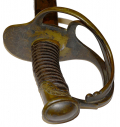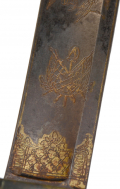site search
online catalog
THE ONLY KNOWN WIDMANN 1840 CAVALRY OFFICER’S SABER: DATED 1844

$10,125.00 SOLD
Originally $13,500.00
Quantity Available: None
Item Code: 870-279
This is a unique opportunity to acquire a one-of-a-kind U.S. cavalry officer’s saber. Frederick W. Widmann emigrated to the U.S. in 1816 and set up business in Philadelphia as a die-sinker and sword-mounter using imported sword blades by 1825. Thillmann notes that, “by the 1840s his product line included a number of regulation style officers’ swords.” To our knowledge, this is the only Widmann Model 1840 cavalry officer’s saber and is dated 1844, the year the government gave a contract for the enlisted version to Ames, who was unable to deliver any until October 1845. It would seem Widmann had an eye on a contract himself or, since no contract was signed for officers’ versions, he intended to compete in the open market on that front. Whatever his objectives, he died just four years later, in 1848.
The sword follows the general lines of the 1840 cavalry saber, though with a slightly deeper curve and more massive hilt. The knuckle bow and heavy branches meet at the juncture with the pommel. The pommel is capped with a broad dome and the only decoration is a branch of leaves up the lower sides. The grip is plain black, now brown, leather with “dragoon twist” wire binding. The knuckle bow and branches have flat lobes where they converge at the pommel, but are otherwise plain, with no cast floral motifs near the pommel or guard. The counterguard is cast smooth, without edge contours inside or out. The upper inside edge (or quillon) is engraved rather simply with a symmetrical sprouting flower and scrolling leaves, looking a little Pennsylvania Dutch, with a diamond latticework showing through at bottom and scrolls at the base (reading it upside down.) The exterior of the counterguard bears a recessed cartouche above the blade and also oriented upside down with raised letters reading, “F.W. WIDMANN / PHILADA.” Under this is stamped the date “1844.” The brass has a mellow age patina overall, but with some fairly strong gilt remaining in recessed areas and on the underside of the counterguard. The leather blade washer is in place. There are no bends or breaks. The leather grip wire and wire are very good.
The blade has a square back and single broad fuller, lacking the shorter narrower fuller of the enlisted 1840 along the back edge, and is decorated with motifs that show up on much earlier imported blades. The lower third of the blade is blued to set off separate gilt-highlighted floral, military and patriotic motifs and features a short, gilt-washed, floral motif on the spine, just in front of the guard. The reverse of the blade features the motto, “HONOUR AND MY COUNTRY” set below a panoply of crossed U.S. flags and cannon, and over a small wreath and leaf motif, with a latticework fence or gate just above the ricasso. The blue is thin, but very evident and the gilt is very good on all the design elements.
The obverse has the same latticework gate above the ricasso, and overhead a small panoply of cannon and flags with a liberty cap on a pole at center. Above that an eagle with a U.S. shield on its chest clutches arrows and an olive branch, with seventeen stars scattered overhead and a knotted ribbon reading E Pluribus Unum. An oval victor’s wreath tops that and the whole is surmounted by a radiant sun with starburst rays and a face at center. As with the reverse, the deeply etched motifs stand out, the gilt wash and fill are good, and the blue is somewhat thin in places, but very evident. There are also portions of the original gold border lines evident as well. The edges and point are good. The non-blued portions of the blade are bright mixed with scattered small gray spots.
The scabbard is iron, with iron mounts, in very good condition. Rings, bands, drag and throat are in place. The throat has a flat mouth and is cut square for the back edge of the blade. There or no dents and just a little crustiness and light pitting at the drag, which is rather short and has a very straight lower edge. The scabbard bears a Roman numeral “XXIII” bench number on the back edge at the throat.
The 1840 saber replaced the relatively light US 1833 dragoon sabers produced by Ames that were the object of some complaint. Perhaps mistrusting his abilities, the government gave the first contract for the new swords to a Solingen firm in 1840, who supplied 2,000. Only in August 1844 did the government give Ames a similar contract. Given the 1844 date of this sword, Widmann may have intended to submit it for trial, perhaps guessing that since a Solingen firm got the first contract his use of German blades would not be a problem, and Ames ended up taking over a year to make his first deliveries. But, Widmann’s eye may well have been private sales to federal and state officers. No government contract was signed for the officer’s version and Ames was unlikely to have produced many, if any, before his 1844 federal contract for the enlisted patterns and possibly not before 1845 when he could actually deliver. The stamped date could be a selling point in the showroom, assuring potential buyers they were looking at the most up to date model, but also suggests Widmann was ahead of the game.
This is a well-made and hefty sword for field service, bearing a pre-Mexican War date and is certainly a contrast to the 1833 patterns produced by Ames. It is also a unique Widmann sword for its pattern and date, just four years before his death. We know of no others. It merits a prominent place in a U.S. sword or cavalry collection. [SR][ph:L]
~~~~~~~~~~~~~~~~~~~~~~~~~~~~~~~~~~~
THIS ITEM, AS WITH ALL OTHER ITEMS AVAILABLE ON OUR WEB SITE,
MAY BE PURCHASED THROUGH OUR LAYAWAY PROGRAM.
CLICK HERE FOR OUR POLICIES AND TERMS.
THANK YOU!
Inquire About THE ONLY KNOWN WIDMANN 1840 CAVALRY OFFICER’S SABER: DATED 1844
For inquiries, please email us at [email protected]
Most Popular
Historical Firearms Stolen From The National Civil War Museum In Harrisburg, Pa »
Theft From Gravesite Of Gen. John Reynolds »
Selection Of Unframed Prints By Don Troiani »
Fine Condition Brass Infantry Bugle Insignia »
British Imported, Confederate Used Bayonet »
Scarce New Model 1865 Sharps Still In Percussion Near Factory New »
featured item
EXCELLENT PAIR OF US BOOTEES/BROGANS
This original pair of standard issue Jefferson Booties, often called “Brogans”, come to us in a virtually pristine condition relative to their age and materials of composition. Showing no signs of outright damage, they do feature some very minor… (490-7151). Learn More »
site search
Upcoming Events
May 16 - 18: N-SSA Spring Nationals, Fort Shenandoah, Winchester, VA Learn More »

































